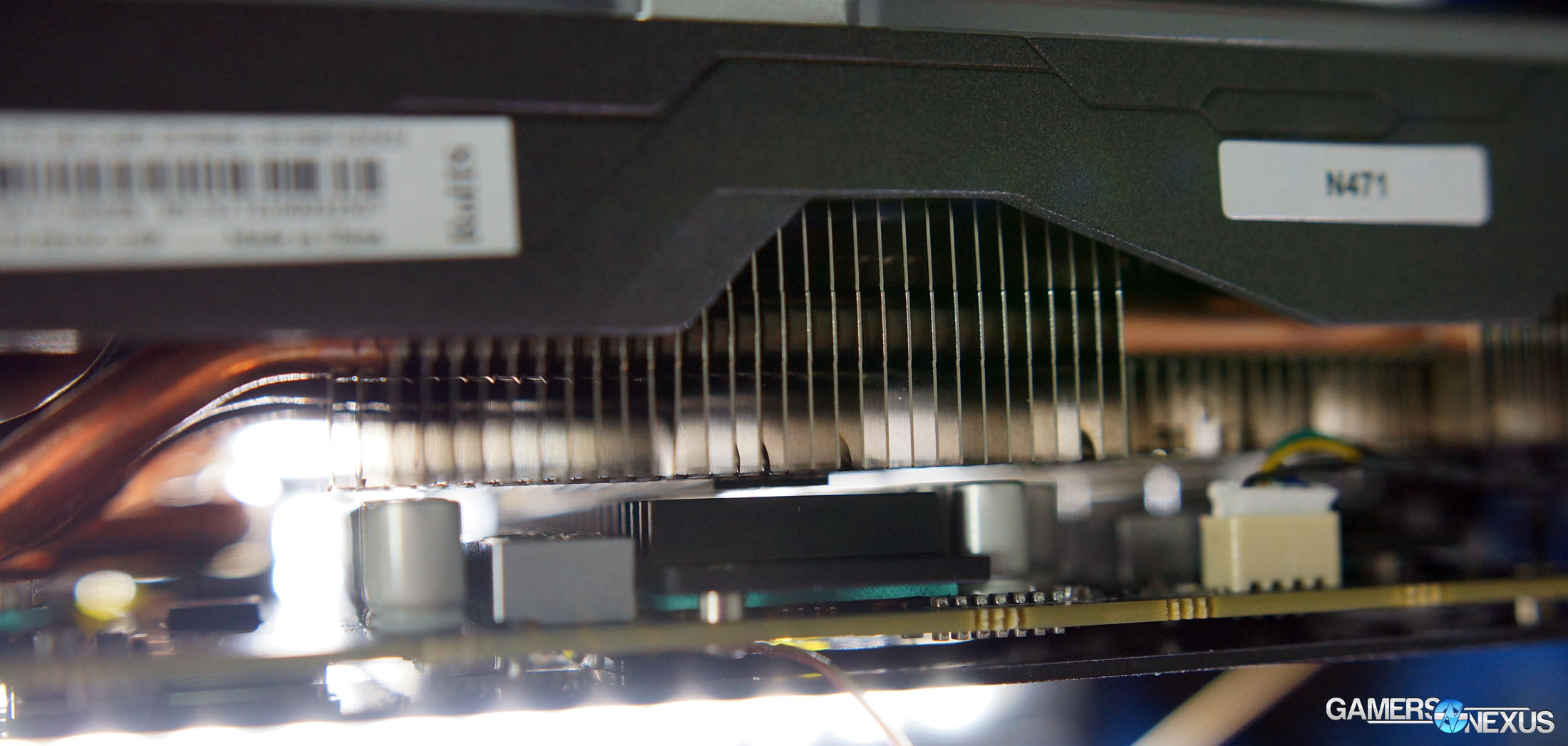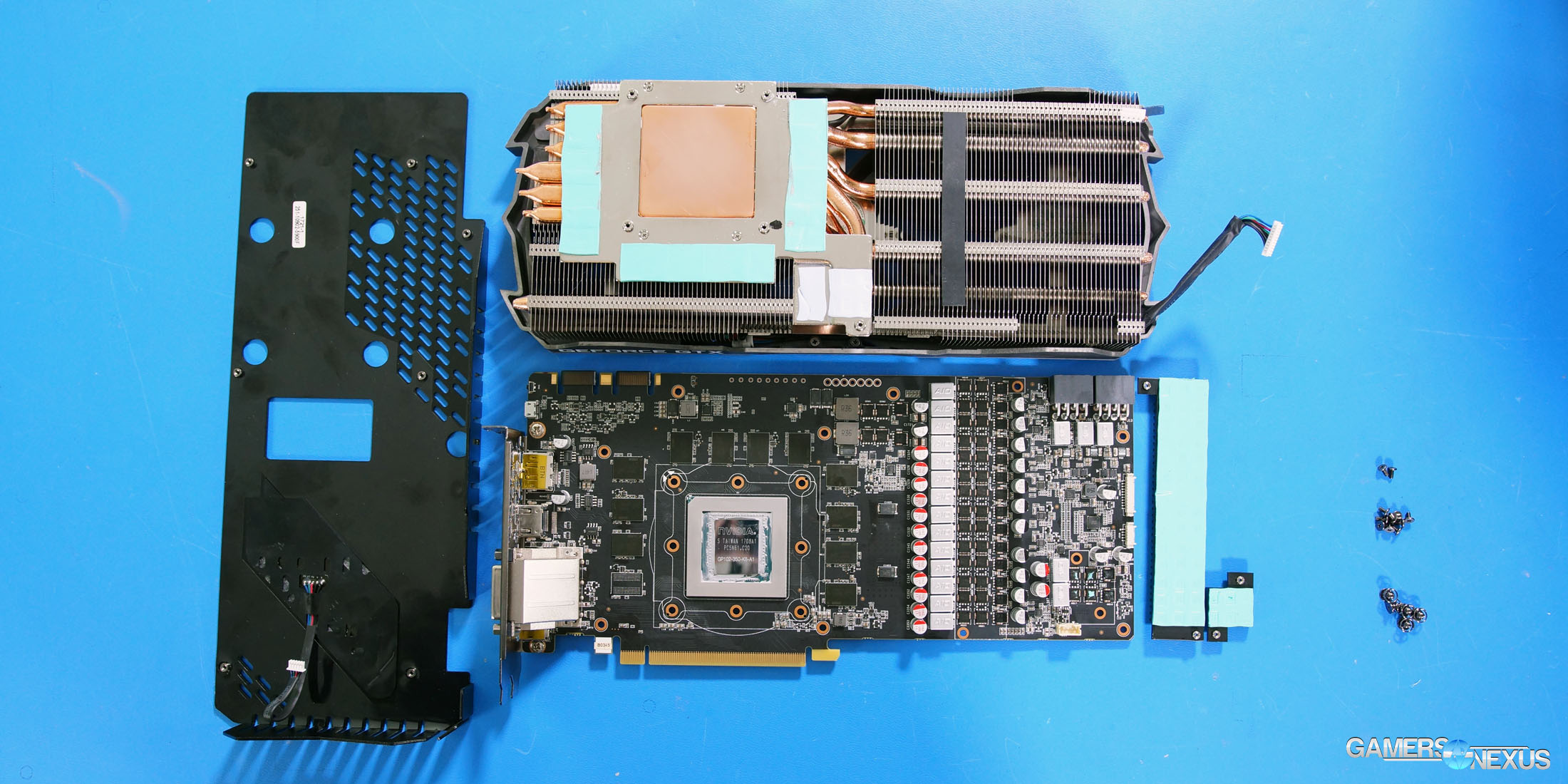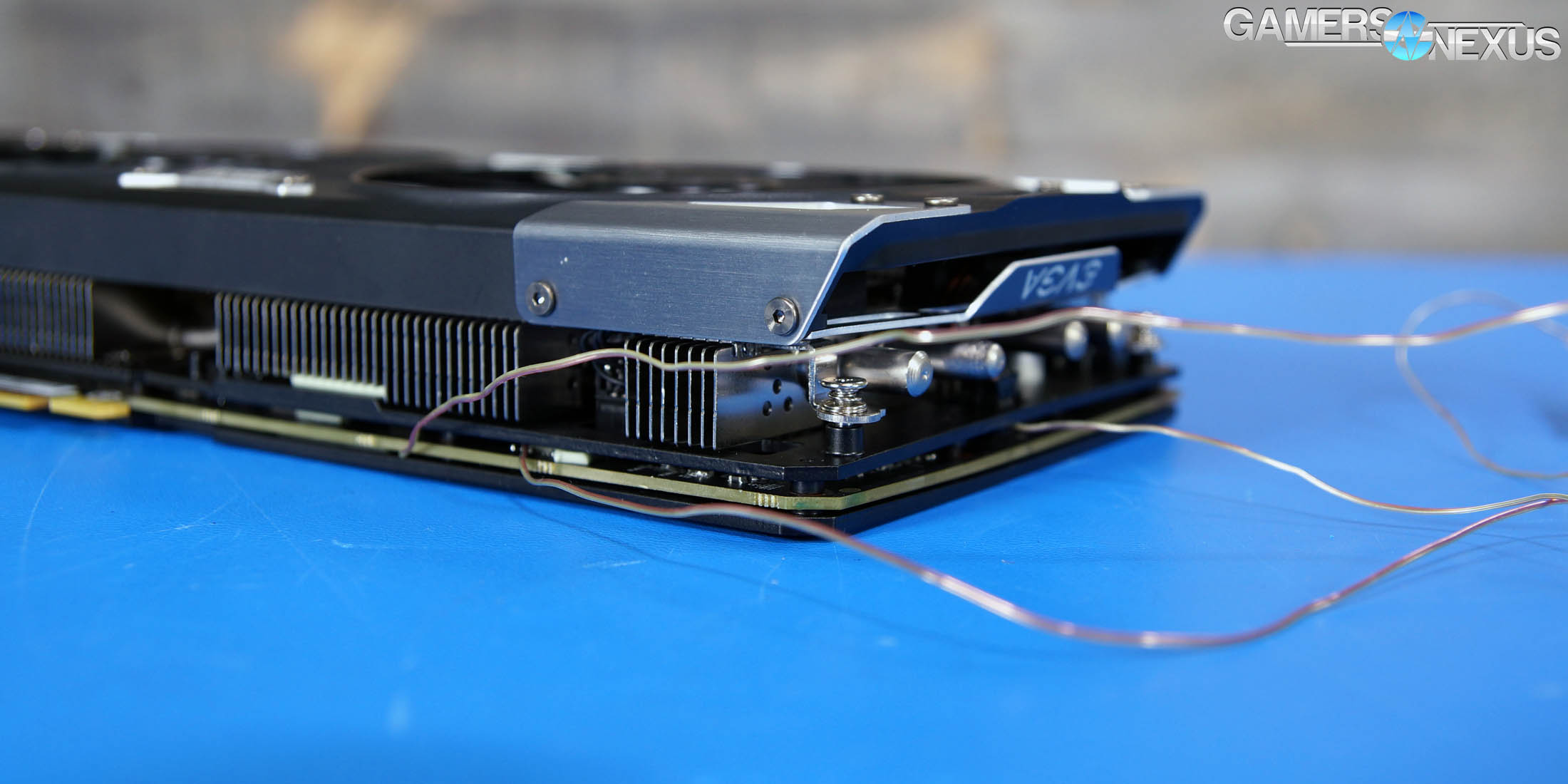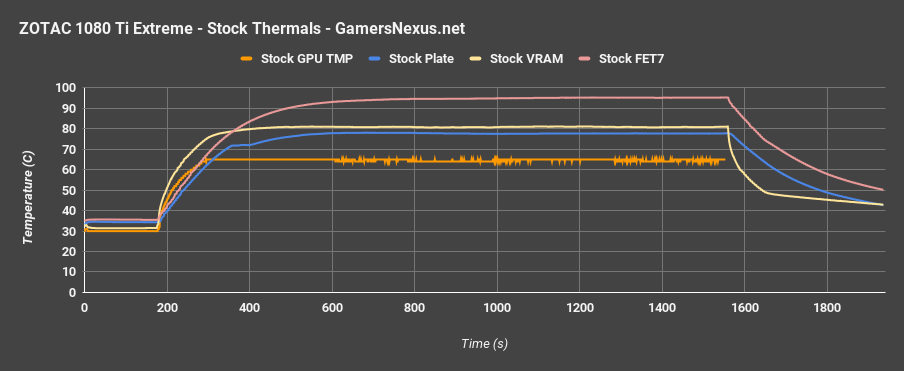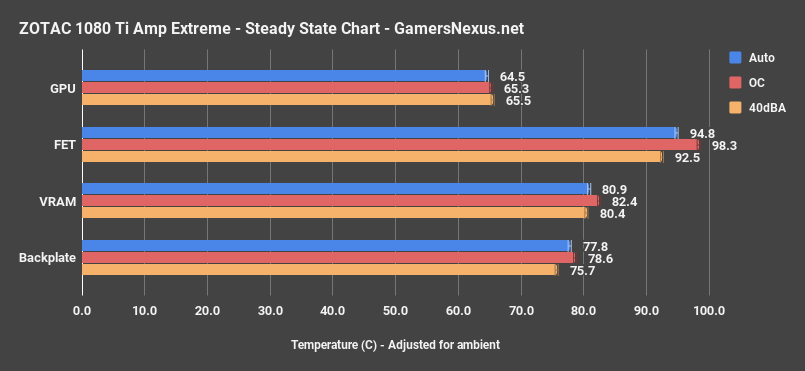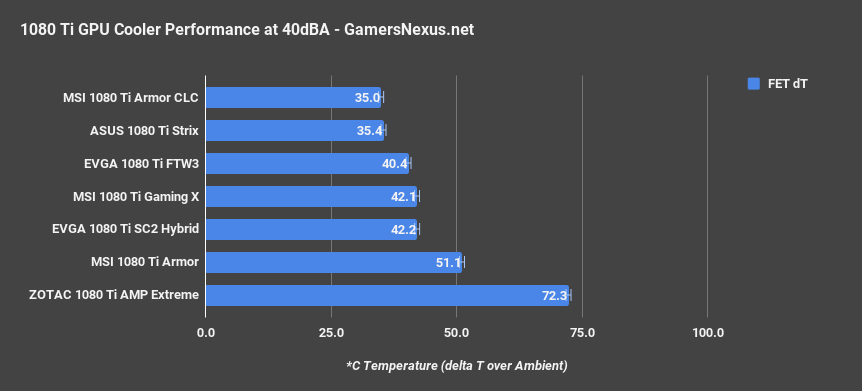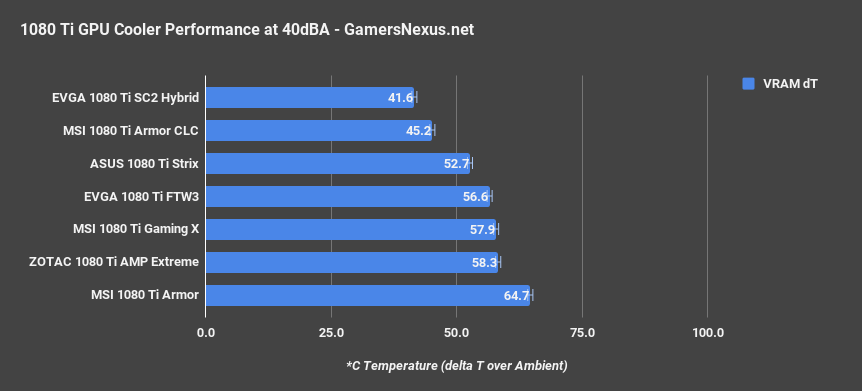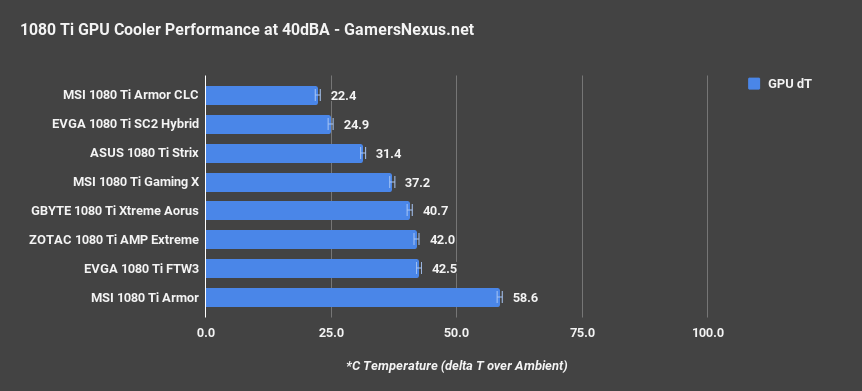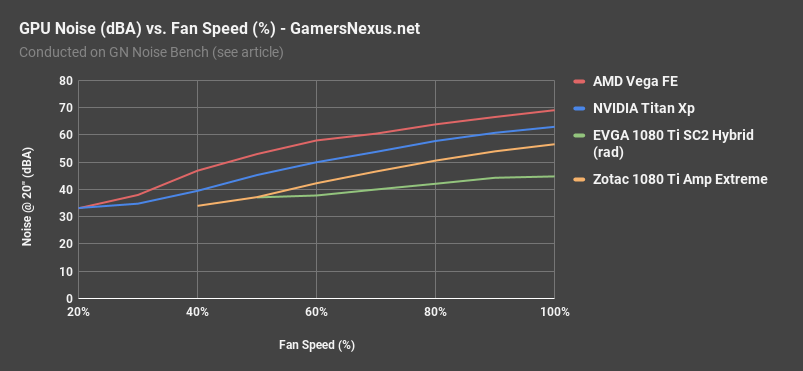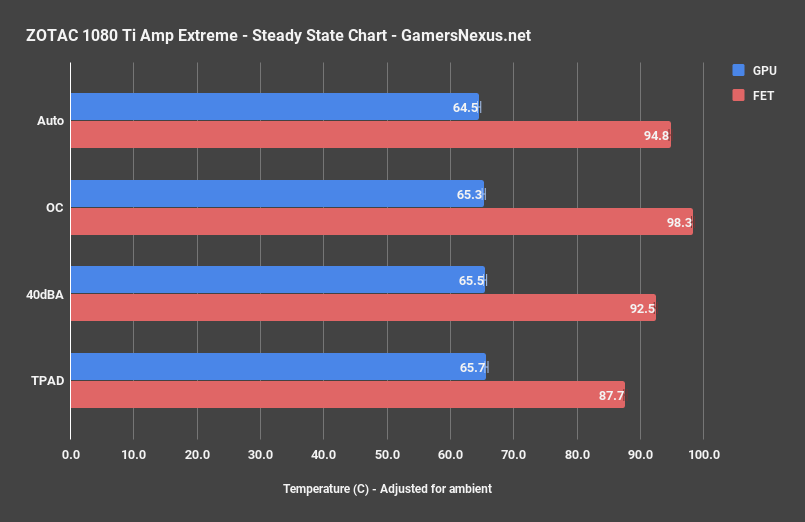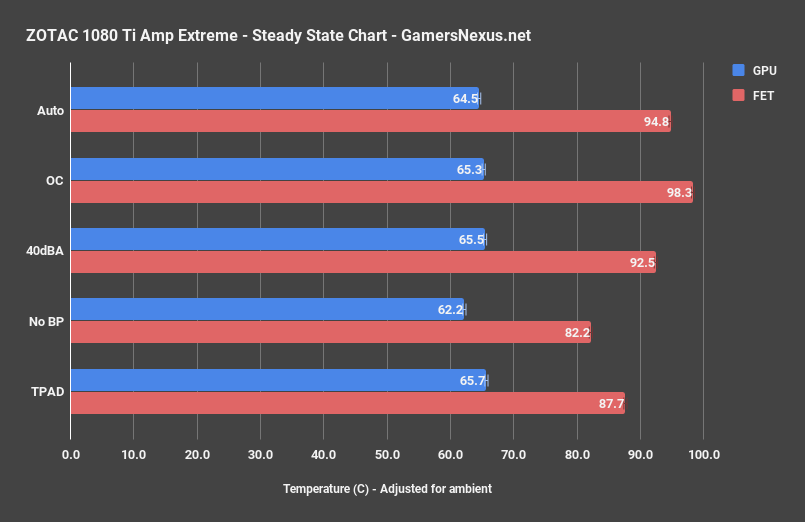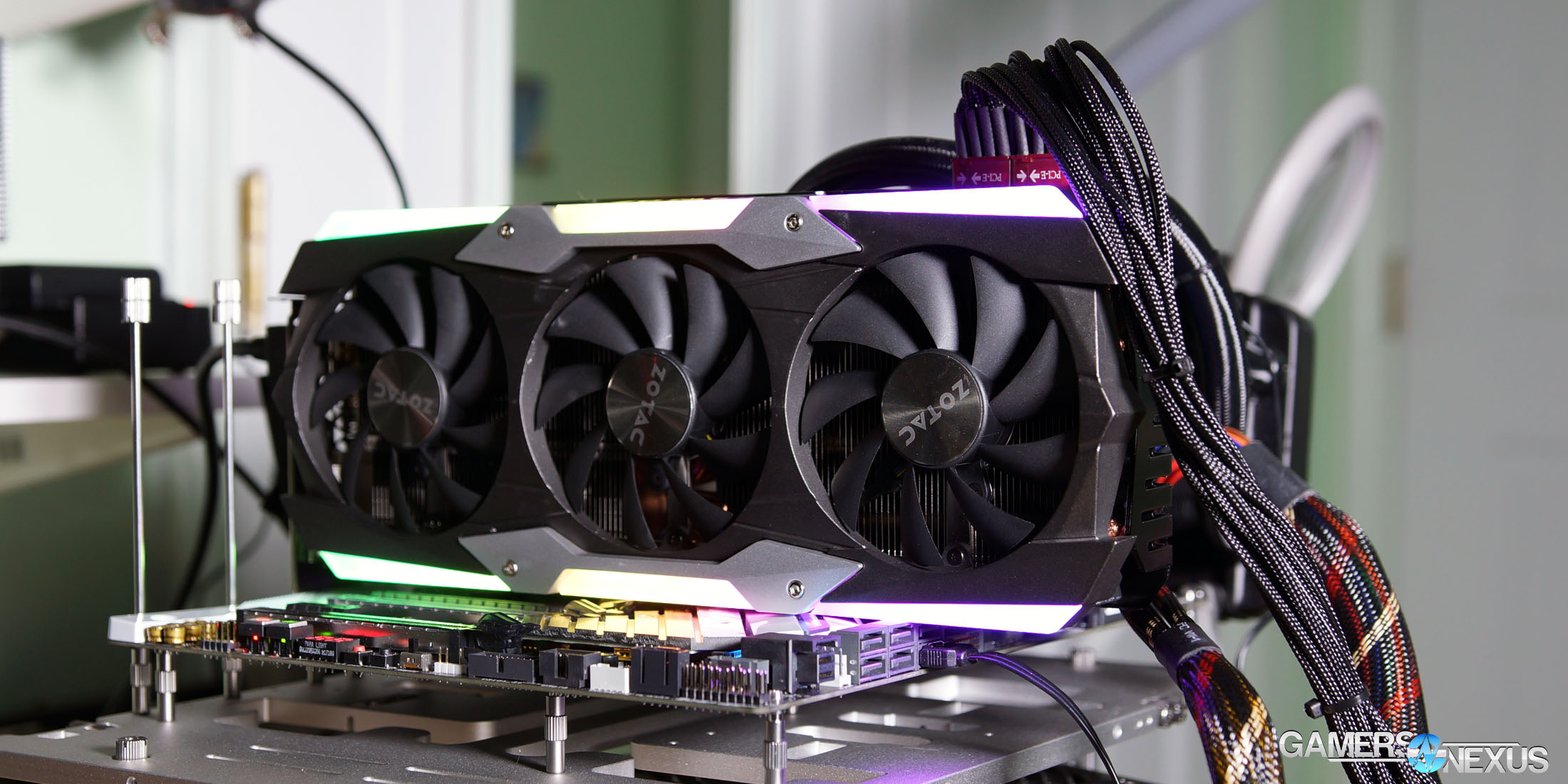Zotac's GTX 1080 Ti AMP! Extreme is one of the largest GTX 1080 Ti cards on the market, rivaling the Gigabyte Aorus Xtreme card in form factor. The card uses nearly three expansion slots, runs a long PCB and cooler, and hosts a dense aluminum heatsink with a three-fan cooler. This card runs $750 to $770, depending on if the “Core” edition is purchased. The only difference is the out-of-box clock, but all these 1080 Tis perform mostly the same in games (once solving for thermals).
For its VRM, Zotac takes a brute-force approach to the 1080 Ti, using a doubled-up 8-phase (16 phases total) with rebranded QN3107 and QN3103 MOSFETs, operating on a UP9511 in 8-phase mode. The VRM is the reason for the tall card, with two phases tucked off to the side (under a small aluminum heatsink that's isolated from all other cooling). This theoretically helps distribute the heat load better across a larger surface area, which Zotac then cools using a small aluminum fin stack that's isolated from the denser aluminum fin array. Above the VRM's isolated heatsink rests a rubber damper, which doesn't fully make contact (and is presumably to prevent scratching in the event of over-flex during installation, as it otherwise does nothing), and then the three fans.
Above: Contactless rubber bumper above the MOSFET heatsink.
The card is one of the heaviest, largest cards we've looked at this generation. To give some perspective, Zotac's AMP Extreme is about 1” thicker than a 2-slot card (like the reference card), is longer than the Aorus Xtreme, and is heavy from the mass of aluminum resting atop the GPU. Learn more about the inner-workings of this card in our tear-down.
For today, we're focusing on thermals, power, and noise, as that's the biggest difference between any of these 1080 Ti cards. The gaming performance and overclocking performance, sans Kingpin/Lightning cards, is not notably different.
GPU Testing Methodology
For our benchmarks today, we’re using a fully rebuilt GPU test bench for 2017. This is our first full set of GPUs for the year, giving us an opportunity to move to an i7-7700K platform that’s clocked higher than our old GPU test bed. For all the excitement that comes with a new GPU test bench and a clean slate to work with, we also lose some information: Our old GPU tests are completely incomparable to these results due to a new set of numbers, completely new testing methodology, new game settings, and new games being tested with. DOOM, for instance, now has a new test methodology behind it. We’ve moved to Ultra graphics settings with 0xAA and async enabled, also dropping OpenGL entirely in favor of Vulkan + more Dx12 tests.
We’ve also automated a significant portion of our testing at this point, reducing manual workload in favor of greater focus on analytics.
Driver version 378.78 (press-ready drivers for 1080 Ti, provided by nVidia) was used for all nVidia devices. Version 17.10.1030-B8 was used for AMD (press drivers).
A separate bench is used for game performance and for thermal performance.
Thermal Test Bench
Our test methodology for the is largely parallel to our EVGA VRM final torture test that we published late last year. We use logging software to monitor the NTCs on EVGA’s ICX card, with our own calibrated thermocouples mounted to power components for non-ICX monitoring. Our thermocouples use an adhesive pad that is 1/100th of an inch thick, and does not interfere in any meaningful way with thermal transfer. The pad is a combination of polyimide and polymethylphenylsiloxane, and the thermocouple is a K-type hooked up to a logging meter. Calibration offsets are applied as necessary, with the exact same thermocouples used in the same spots for each test.
Torture testing used Kombustor's 'Furry Donut' testing, 3DMark, and a few games (to determine auto fan speeds under 'real' usage conditions, used later for noise level testing).
Our tests apply self-adhesive, 1/100th-inch thick (read: laser thin, does not cause "air gaps") K-type thermocouples directly to the rear-side of the PCB and to hotspot MOSFETs numbers 2 and 7 when counting from the bottom of the PCB. The thermocouples used are flat and are self-adhesive (from Omega), as recommended by thermal engineers in the industry -- including Bobby Kinstle of Corsair, whom we previously interviewed.
K-type thermocouples have a known range of approximately 2.2C. We calibrated our thermocouples by providing them an "ice bath," then providing them a boiling water bath. This provided us the information required to understand and adjust results appropriately.
Because we have concerns pertaining to thermal conductivity and impact of the thermocouple pad in its placement area, we selected the pads discussed above for uninterrupted performance of the cooler by the test equipment. Electrical conductivity is also a concern, as you don't want bare wire to cause an electrical short on the PCB. Fortunately, these thermocouples are not electrically conductive along the wire or placement pad, with the wire using a PTFE coating with a 30 AWG (~0.0100"⌀). The thermocouples are 914mm long and connect into our dual logging thermocouple readers, which then take second by second measurements of temperature. We also log ambient, and apply an ambient modifier where necessary to adjust test passes so that they are fair.
The response time of our thermocouples is 0.15s, with an accompanying resolution of 0.1C. The laminates arae fiberglass-reinforced polymer layers, with junction insulation comprised of polyimide and fiberglass. The thermocouples are rated for just under 200C, which is enough for any VRM testing (and if we go over that, something will probably blow, anyway).
To avoid EMI, we mostly guess-and-check placement of the thermocouples. EMI is caused by power plane PCBs and inductors. We were able to avoid electromagnetic interference by routing the thermocouple wiring right, toward the less populated half of the board, and then down. The cables exit the board near the PCI-e slot and avoid crossing inductors. This resulted in no observable/measurable EMI with regard to temperature readings.
We decided to deploy AIDA64 and GPU-Z to measure direct temperatures of the GPU and the CPU (becomes relevant during torture testing, when we dump the CPU radiator's heat straight into the VRM fan). In addition to this, logging of fan speeds, VID, vCore, and other aspects of power management were logged. We then use EVGA's custom Precision build to log the thermistor readings second by second, matched against and validated between our own thermocouples.
The primary test platform is detailed below:
| GN Test Bench 2015 | Name | Courtesy Of | Cost |
| Video Card | This is what we're testing | - | - |
| CPU | Intel i7-5930K CPU 3.8GHz | iBUYPOWER | $580 |
| Memory | Corsair Dominator 32GB 3200MHz | Corsair | $210 |
| Motherboard | EVGA X99 Classified | GamersNexus | $365 |
| Power Supply | NZXT 1200W HALE90 V2 | NZXT | $300 |
| SSD | OCZ ARC100 Crucial 1TB | Kingston Tech. | $130 |
| Case | Top Deck Tech Station | GamersNexus | $250 |
| CPU Cooler | Asetek 570LC | Asetek | - |
Note also that we swap test benches for the GPU thermal testing, using instead our "red" bench with three case fans -- only one is connected (directed at CPU area) -- and an elevated standoff for the 120mm fat radiator cooler from Asetek (for the CPU) with Gentle Typhoon fan at max RPM. This is elevated out of airflow pathways for the GPU, and is irrelevant to testing -- but we're detailing it for our own notes in the future.
Game Bench
| GN Test Bench 2017 | Name | Courtesy Of | Cost |
| Video Card | This is what we're testing | - | - |
| CPU | Intel i7-7700K 4.5GHz locked | GamersNexus | $330 |
| Memory | GSkill Trident Z 3200MHz C14 | Gskill | - |
| Motherboard | Gigabyte Aorus Gaming 7 Z270X | Gigabyte | $240 |
| Power Supply | NZXT 1200W HALE90 V2 | NZXT | $300 |
| SSD | Plextor M7V Crucial 1TB | GamersNexus | - |
| Case | Top Deck Tech Station | GamersNexus | $250 |
| CPU Cooler | Asetek 570LC | Asetek | - |
BIOS settings include C-states completely disabled with the CPU locked to 4.5GHz at 1.32 vCore. Memory is at XMP1.
We communicated with both AMD and nVidia about the new titles on the bench, and gave each company the opportunity to ‘vote’ for a title they’d like to see us add. We figure this will help even out some of the game biases that exist. AMD doesn’t make a big showing today, but will soon. We are testing:
- Ghost Recon: Wildlands (built-in bench, Very High; recommended by nVidia)
- Sniper Elite 4 (High, Async, Dx12; recommended by AMD)
- For Honor (Extreme, manual bench as built-in is unrealistically abusive)
- Ashes of the Singularity (GPU-focused, High, Dx12)
- DOOM (Vulkan, Ultra, 0xAA, Async)
Synthetics:
- 3DMark FireStrike
- 3DMark FireStrike Extreme
- 3DMark FireStrike Ultra
- 3DMark TimeSpy
For measurement tools, we’re using PresentMon for Dx12/Vulkan titles and FRAPS for Dx11 titles. OnPresent is the preferred output for us, which is then fed through our own script to calculate 1% low and 0.1% low metrics (defined here).
Power testing is taken at the wall. One case fan is connected, both SSDs, and the system is otherwise left in the "Game Bench" configuration.
Zotac 1080 Ti Amp Extreme Thermals – Stock vs. Time
Starting with a stock thermals chart, we see that the 1080 Ti Amp Extreme card operates its GPU temperature reasonably – around the 66C mark – when under auto conditions. We’ll look at 40dBA testing in a moment. 66C is comparable to what some other AIB partner 1080 Ti models target for auto operating range. This auto configuration also places the card’s power component temperatures in the 90s, nearing 100C, with a steady state temperature of 95C. The VRAM is around 81C steady state. That’s getting hot on the VRM, and is entering the realm of EVGA’s ACX card fracas prior to the thermal pad update.
Zotac 1080 Ti Amp Extreme Thermals – Steady State
Before getting to the comparative charts, here’s a look at one of our steady state charts to show steady state thermals under various test conditions. Overclocked, our GPU temperatures remain consistent when operating at a fixed RPM, so we’re soaking the extra 20% power and +50MHz core pretty well, and the VRAM increases by about 2C from our +400MHz VRAM overclock. The VRM components are pushing up to 98C external temperature, and that’s with a 22-23C ambient with one 120mm fan providing airflow over the backplate. If you put this card in a case, it would not be unreasonable to see a 40C internal ambient, which would boost VRM temperatures into the range of 110-120C.
Zotac is still technically within spec here; they haven't done anything yet that violates VRM thermal specifications, as most FET components can handle 125-150C. That said, it's still unnecessarily warm. Zotac has all this surface area on the PCB (and the cooler), yet none of it really gets used for VRM cooling. The solution is running far warmer than necessary, and that's entirely relegated to poor design. “Within spec” isn't really the goal that should be set, particularly not with a premium-priced card. Zotac can do better than this – all their competitors have, and some with cards that are a full 1” smaller in width.
Zotac 1080 Ti Amp Extreme Comparative Thermals
Let’s get some perspective. Looking at other devices on a steady state chart, we’re now testing for thermals with noise normalized at a 40dBA output. The MOSFET chart positions the Zotac Amp Extreme so significantly hotter than the other cards that it’s actually impressive – that is, it’s impressive they’ve managed to design a heatsink and fan solution so bad at cooling, and that’s with one of the biggest cards on the market. This is a 3-fan cooler that takes nearly 3 full PCIe slots, and somehow it’s managing a 72C delta T over ambient power component temperature, or nearly 100C. That makes this card 20C hotter than the previous worst card on the bench, the 1080 Ti Armor – and the 1080 Ti Armor uses what effectively amounts to a GTX 1070 cooler.
Looking at 40dBA VRAM temperatures, the Zotac 1080 Ti Amp Extreme posts a reasonable performance of 58.3C delta T over ambient temperature, with the 1080 Ti Armor still worst. This places the Extreme around where the Gaming X and FTW3 performed. Not bad for Zotac, here, but then again, the VRAM is cooled directly and actually uses thermal pads to contact the cooling plate.
GPU temperatures at 40dBA are also somewhat reasonable, with the Extreme at 42C delta T over ambient. This is around the FTW3 and Xtreme Aorus, with the ASUS Strix ROG card still hanging onto the title for best air-cooled card. The next coolest are both under liquid.
A lot of this is because of Zotac's failure to dump the VRM heat from the card. The VRM heatsink is not only thermally isolated and not making conductive contact to the larger heatsink, it very nearly functions as a heat trap. The rubber bumper above the VRM heatsink (which does not contact inductors and does not damp coil whine – also, a thermal pad would do the same thing) is blocking some airflow, isn't making contact anyway (and so does nothing), and doesn't transfer heat. This is starting to sound like EVGA's ACX cooler situation from last year.
We next decided to add a thermal pad on top of the VRM heatsink, just to see what the difference would look like. We actually had to do this by stacking two thermal pads, since we didn’t have a thicker unit available. This limits performance since you’re now transferring between two interfaces, which means that our “fix” isn’t even that good – but it’s still better than what Zotac shipped, and they definitely have access to better thermal pads than we do.
Thermal Pad Mod – Zotac 1080 Ti Amp Extreme
The difference in power component temperatures is an improvement of 7.1C, moving from roughly 94.8C to 87.7C. Using a better thermal pad would improve that further.
Here’s where it gets really interesting: If we remove the backplate for the next test, with the original rubber bumper on the VRM heatsink and with fans fixed at around 45% for both benchmarks (as that’s where Auto would normally land), we see that Zotac is heating up its own card with a what amounts to a plastic backplate.
With the backplate removed, the GPU temperatures remain more or less the same – we’re at 2C difference, which is still an improvement, so that’s not exciting. What is exciting is that the power component temperatures improve by 13C. That’s 95C to 82C, which is completely reasonable for a VRM temperature. VRAM temperatures improve by 15C. We go from 80.9C to 65.7C, adjusted for ambient. Zotac could learn something from EVGA’s thermal pad response.
Conclusion: Bigger Isn't Better
Building the biggest card doesn't make it inherently better at anything. Zotac's 1080 Ti Amp Extreme doesn't have the best VRM (and uses rebranded components, so we can't get datasheets, anyway) and doesn't have the best cooling. This is a card which squanders its size advantage with poor design, resulting in a nearly 3-slot card which has thermal performance (as a whole) worse than 2-slot competitors, some at lower prices. Entering the ultra high-end market, occupied by the ASUS Strix card, Zotac can't compete in noise-to-thermals. Looking instead at the ~$750 market, you get competitors like the MSI Gaming X and EVGA SC2, both of which operate better in the noise-to-thermals department across the entire board.
Zotac is left in an odd spot. The Amp Extreme isn't particularly good at any one thing. It's just sort of OK – or downright warm, in some instances – and that's simply not good enough to compete at its price. The primary reason to buy the card would be looks and the digital RGB LEDs, at this point, which isn't necessarily a bad thing – it's just unfortunate that Zotac couldn't put their surface area to better use.
Editorial: Steve Burke
Video: Andrew Coleman
